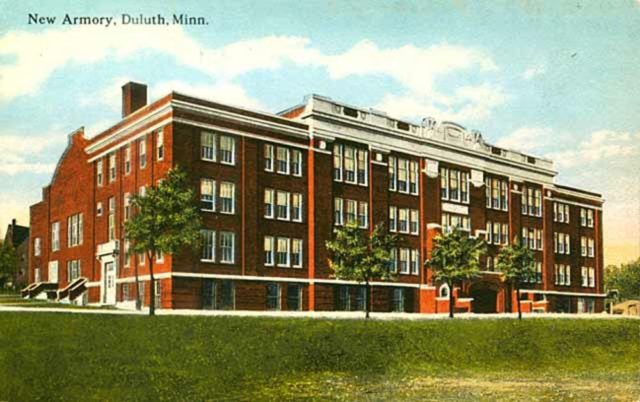Although the NorShor Theater restoration will likely be completed before the restoration of the 1915 vintage Armory is, it’s certainly not a race. Both projects have been on the table, so to speak, for several years and none has overcome more obstacles than the Armory project has since the not for profit group paid $1.00 for the facility in 2003.
During the floods of 2012 the basement completely flooded and much of the infrastructure there was damaged, mud was a couple of feet deep and anything on the floor was lost…then, in 2014, a mass of snow and ice on the roof of the former drill hall slid down with such force that it knocked a brick parapet wall off the building…but neither of these catastrophes has dampened the enthusiasm of a small group of dedicated preservationists who are committed to preserving the building and the history created within those walls.
As an Armory, soldiers were trained in the drill hall including marksmanship in the hand dug trenches in the basement and target practice on the firing range. Soldiers were marshaled there before marching in file to the Union Depot (another re-purposed architectural gem) to board trains for training camps before heading into battle during both World War I and World War II. The Armory housed both the National Guard and the Naval Militia. The first military action initiated there was the protection of our border with Mexico from raids by Poncho Villa.
You might be interested to know that one of the largest funerals in Duluth’s history was held there when Albert Woolson, Duluthian and last living soldier of the Civil War, was eulogized there before his horse drawn caisson was followed by hundreds of mourners on the way to the cemetery. For these reasons, the property was nominated and selected for inclusion on the National Register of Historic Places.
The facility also housed refugees from the Cloquet river valley when fire swept that entire region in 1918 and provided shelter from winter storms whenever needed.
In addition to this vital history, and between military uses, the facility also served the cultural and entertainment needs of our community. The Armory served as the home for the DSSO almost from inception in 1932 until the present Symphony Hall within the DECC was completed in 1966. While it might be nice to return to our “roots” the size of the stage and the fact that the floor is flat (no rake) make moving the symphony back to the Armory unappealing. The Armory also hosted sock-hops, operatic performances, car show, circuses and countless rock-and-roll concerts before the DECC was built.
Another interesting highlight in the history of the Armory is that Pulitzer Prize winner, Bob Dylan, was a regular patron and became so inspired by the performance of Buddy Holly just days before Holly died in a plane crash on his way to a performance in Iowa that he went on to become an internationally recognized musician, poet and legend.
The Armory Arts & Music Center is the official name of the group which has overseen the investment of over a million dollars to preserve the structure. During the first week of November, the Minnesota Historical Society, through their administered Legacy Grant program, awarded an additional $250,000.00 to be used to preserve the floor in the hip domed drill space. The floor in this area was badly damaged when the City of Duluth used the facility to house snow removal equipment which leached much salt onto the floor causing the steel infrastructure to be compromised.
Through the years, the AAMC has fought off demolition successfully. Having local landmark status, being listed on the National Register of Historic Places (along with the Lift Bridge and Glensheen) has not stopped some from calling for the demolition of the building…regardless of the fact that a creek runs under the building making the reuse of the land which would be vacated by the demolition impossible.
The AAMC has recently engaged the professional services of the Boisclair Corporation to assist them in developing the property into a mixed use commercial building. The current plan has a mix of apartments, office spaces, studio spaces, and underground parking for the apartments as well as reusing the historic stage and the huge hall for community events or possibly even a restaurant. If highly respected and experienced Boisclair Corporation’s investigation of the market and uses possibilities is successful, construction could begin as soon as the spring of 2017.
Historic preservation is not a quick process, but it certainly has been a vital ingredient to tourism in Duluth. Just a short list of properties which have been saved from the wrecking ball by preservationists include Fitgers, the NorShore Theater, the Depot Heritage and Arts Center, Tycoons (now the Blind Pig), Greysolon Plaza, the Zeitgeist Arts Center, Munger Terrace, and the former Marshall-Wells facility, and, yes, Glensheen…to name just a few. Membership in the Duluth Preservation Alliance (DuluthPreservation.org) is free, fun and rewarding. The mission of the DPA is, “Advocating for the preservation of Duluth’s historic architecture”. I would be remiss if I did not note that I am an officer of the DPA and a member of the boards of the Depot Foundation and Glensheen and serve on the Executive Council of the Minnesota Historical Society.

